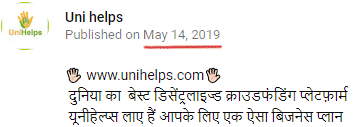UniHelps Review: Seven-tier 2×2 matrix Ponzi cycler
 UniHelps provides no information on their website about who owns or runs the business.
UniHelps provides no information on their website about who owns or runs the business.
The UniHelps website domain (“unihelps.com”) was registered on April 1st, 2019.
No details other than the location Paris, France are provided in the registration.
On UniHelps’ official Facebook page, the company location provided is Delhi, India.
This corresponds with Hindi language marketing videos and descriptions on UniHelps official YouTube channel:

It is highly likely that whoever is running UniHelps is based out of India itself.
As always, if an MLM company is not openly upfront about who is running or owns it, think long and hard about joining and/or handing over any money.
UniHelps Products
UniHelps has no retailable products or services, with affiliates only able to market UniHelps affiliate membership itself.
The UniHelps Compensation Plan
UniHelps affiliates invest $100 into a seven-tier 2×2 matrix cycler.
A 2×2 matrix places a UniHelps affiliate at the top of a matrix, with two positions directly under them:

These two positions form the first level of the matrix.
The second level of the matrix is generated by splitting these first two positions into another two positions each (4 positions).
Positions in the matrix are filled via position purchases by new and existing UniHelps affiliates.
Once all six positions are filled, a “cycle” is generated and a commission paid out.
Commission payments across all seven UniHelps matrix cycler tiers are as follows:
- Tier 1 (positions cost $100) – $300 cycle commission and cycles into Tier 2
- Tier 2 – $600 cycle commission and cycles into Tier 3
- Tier 3 – $1200 cycle commission and cycles into Tier 4
- Tier 4 – $2400 cycle commission and cycles into Tier 5
- Tier 5 – $4800 cycle commission and cycles into Tier 6
- Tier 6 – $9600 cycle commission and cycles into Tier 7
- Tier 7 – $19,200 cycle commission (must reinvest $100 to start again)
Joining UniHelps
UniHelps affiliate membership is tied to a minimum $100 cycler investment.
Conclusion
UniHelps claims to be the “world’s largest peer to peer crowdfunding system”.
Any time you see “peer to peer” or “crowdfunding” used to describe an MLM opportunity, that means affiliates are sending money to each other.
That by itself is cash gifting. When coupled with a matrix cycler however, it becomes a Ponzi scheme.
UniHelps themselves even drop the facade in one of their marketing videos:

The Ponzi aspect of UniHelps exists by way of affiliates investing $100 and then being paid out of subsequent $100 investments.
No matter the cycler tier, returns are pushed along by new $100 investments across Tier 1.
The overall math behind UniHelps is $100 in and $38,100 out.
Just one complete return payout requires three hundred and eighty one $100 investments. Those initial 381 investments in turn require 145,161 new investments to cycle through all seven tiers.
And from there things quickly spiral out of control.
One other thing I noticed is this verbiage from UniHelps’ website;
It is based on the world famous Mobius Loop and the system G Technology, which is the most successful Peer-To-Peer Team Crowdfunding Program in history!
I’ve only ever seen the terms “mobius loop” and “system G technology” used to market one other scheme, David Rosen’s 50/50 Crowdfunding.
The terms are meaningless scam jargon themselves, but suggest whoever is running UniHelps was involved in 50/50 Crowdfunding.
50/50 Crowdfunding uses the same 2×2 matrix Ponzi cycler model as UniHelps. Not surprisingly, Alexa currently pegs India as the top source of traffic to the 50/50 Crowdfunding website (76%).
As with all cycler Ponzi schemes, once new $100 investment dry off UniHelp’s matrices will begin to stall.
Once enough matrices stall, an irreversible collapse is triggered.
The math behind Ponzi schemes like UniHelp guarantees that when they collapse, the majority of participants lose money.

